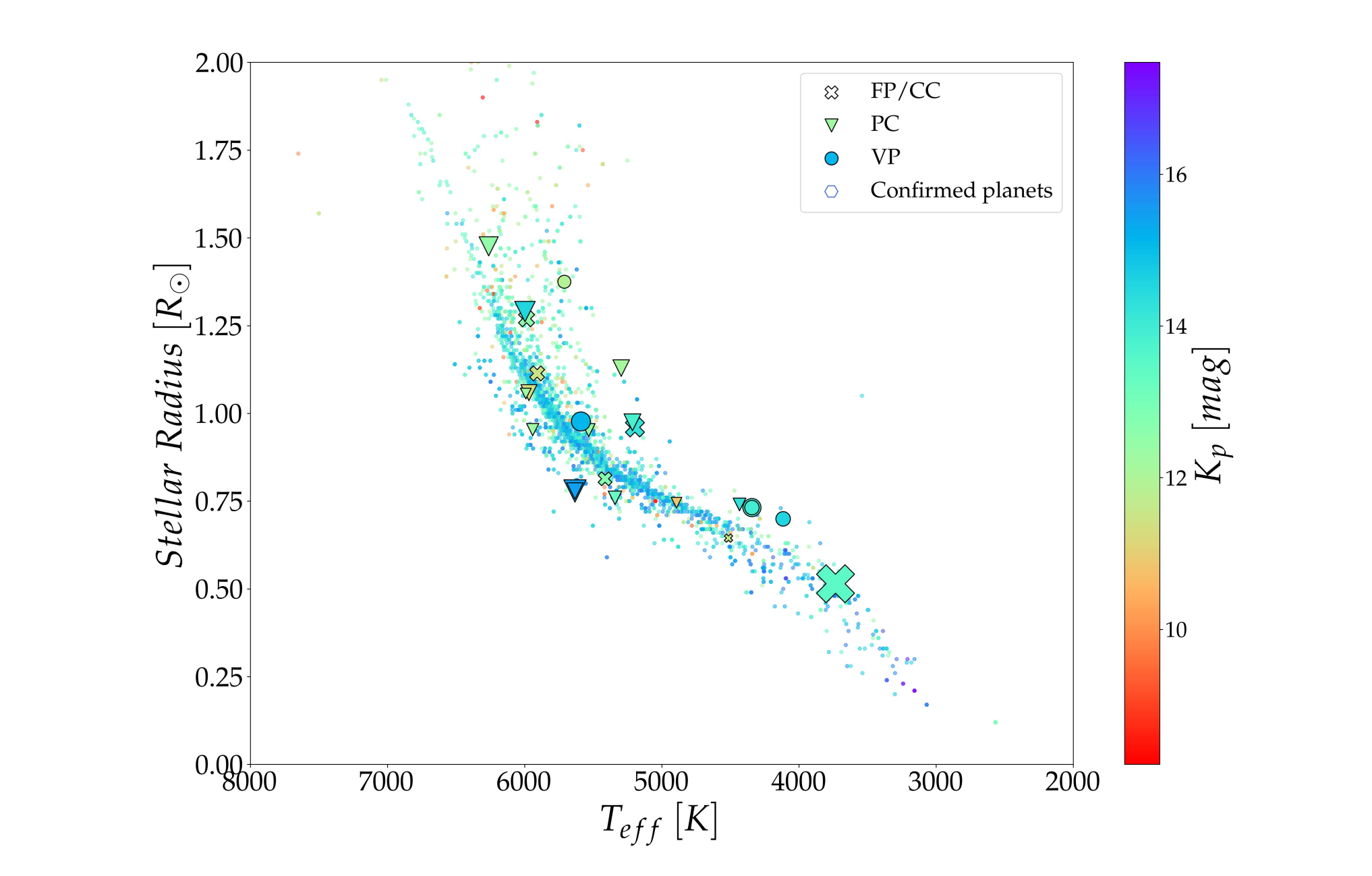
Distribution of the host stars of our validated (circles), candidate (triangles), and false positive (crosses) sample versus the stellar properties of the hosts stars of know planets from the NASA Exoplanet Archive (hexagons). The sizes of the markers from our sample are scaled to the MCMC best-fit planetary radius. — astro-ph.EP
Searching for Earth-sized planets in data from Kepler’s extended mission (K2) is a niche that still remains to be fully exploited.
The TFAW survey is an ongoing project that aims to re-analyze all light curves in K2 C1-C8 and C12-C18 campaigns with a wavelet-based detrending and denoising method, and the period search algorithm TLS to search for new transit candidates not detected in previous works.
We have analyzed a first subset of 24 candidate planetary systems around relatively faint host stars (10.9 < Kp < 15.4) to allow for follow-up speckle imaging observations. Using VESPA and TRICERATOPS, we statistically validate six candidates orbiting four unique host stars by obtaining false-positive probabilities smaller than 1% with both methods.
We also present 13 vetted planet candidates that might benefit from other, more precise follow-up observations. All of these planets are sub-Neptune-sized, with two validated planets and three candidates with sub-Earth sizes, and have orbital periods between 0.81 and 23.98 days. Some interesting systems include two ultra-short-period planets, three multi-planetary systems, three sub-Neptunes that appear to be within the small planet Radius Gap, and two validated and one candidate sub-Earths (EPIC 210706310, EPIC 210768568, and EPIC 246078343) orbiting metal-poor stars.
D. del Ser (1 and 2), O. Fors (2), M. del Alcázar (1 and 2), V. Dyachenko (3), E. P. Horch (4), A. Tokovinin (5), C. Ziegler (6), G. T. van Belle (7), C. A. Clark (7 and 8), Z. D. Hartman (9) ((1) Observatori Fabra, Reial Acadèmia de Ciències i Arts de Barcelona, (2) Dept. de Física Quàntica i Astrofísica, Institut de Ciències del Cosmos (ICCUB), Universitat de Barcelona, IEEC-UB, (3) Special Astrophysical Observatory, (4) Department of Physics, Southern Connecticut State University, (5) Cerro Tololo Inter-American Observatory, (6) Department of Physics, Engineering and Astronomy, Stephen F. Austin State University, (7) Lowell Observatory, (8) Northern Arizona University, (9) Gemini Observatory/NSF’s NOIRLab)
Comments: Submitted to Monthly Notices of the Royal Astronomical Society. 25 pages, 14 figures
Subjects: Earth and Planetary Astrophysics (astro-ph.EP)
Cite as: arXiv:2210.10805 [astro-ph.EP] (or arXiv:2210.10805v1 [astro-ph.EP] for this version)
Submission history
From: Daniel Del Ser Badia
[v1] Wed, 19 Oct 2022 18:00:08 UTC (16,435 KB)
https://arxiv.org/abs/2210.10805
Astrobiology
https://news.google.com/__i/rss/rd/articles/CBMib2h0dHBzOi8vYXN0cm9iaW9sb2d5LmNvbS8yMDIyLzEwL3RmYXctc3VydmV5LWlpLTYtbmV3bHktdmFsaWRhdGVkLXBsYW5ldHMtYW5kLTEzLXBsYW5ldC1jYW5kaWRhdGVzLWZyb20tazIuaHRtbNIBAA?oc=5
2022-10-24 00:52:50Z
CBMib2h0dHBzOi8vYXN0cm9iaW9sb2d5LmNvbS8yMDIyLzEwL3RmYXctc3VydmV5LWlpLTYtbmV3bHktdmFsaWRhdGVkLXBsYW5ldHMtYW5kLTEzLXBsYW5ldC1jYW5kaWRhdGVzLWZyb20tazIuaHRtbNIBAA
Bagikan Berita Ini















0 Response to "TFAW survey II: 6 Newly Validated Planets And 13 Planet Candidates From K2 - Astrobiology - Astrobiology News"
Post a Comment